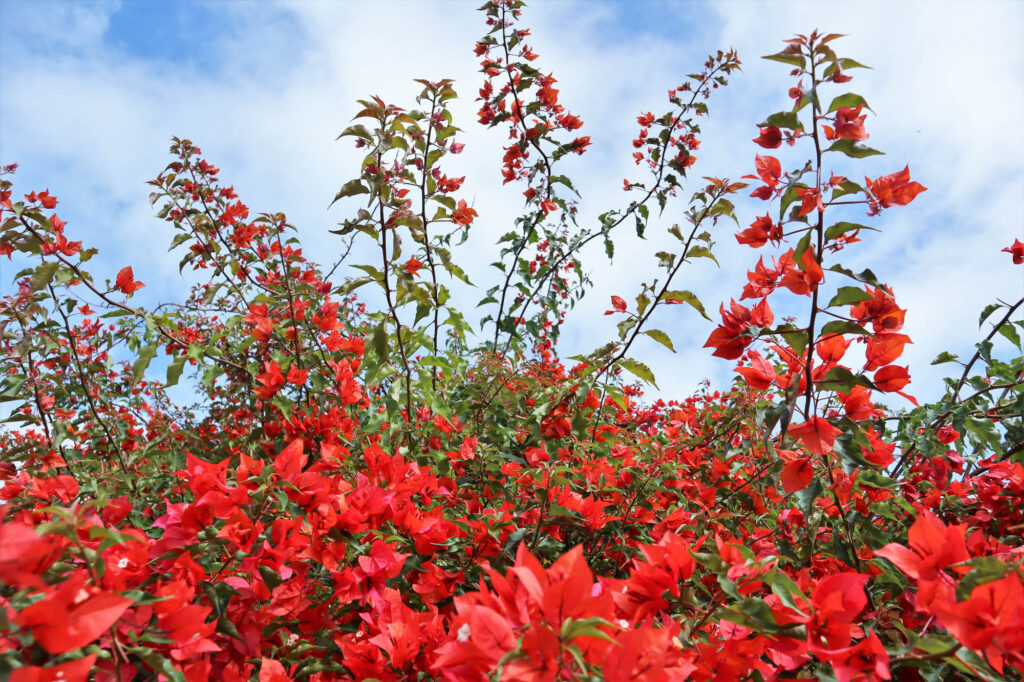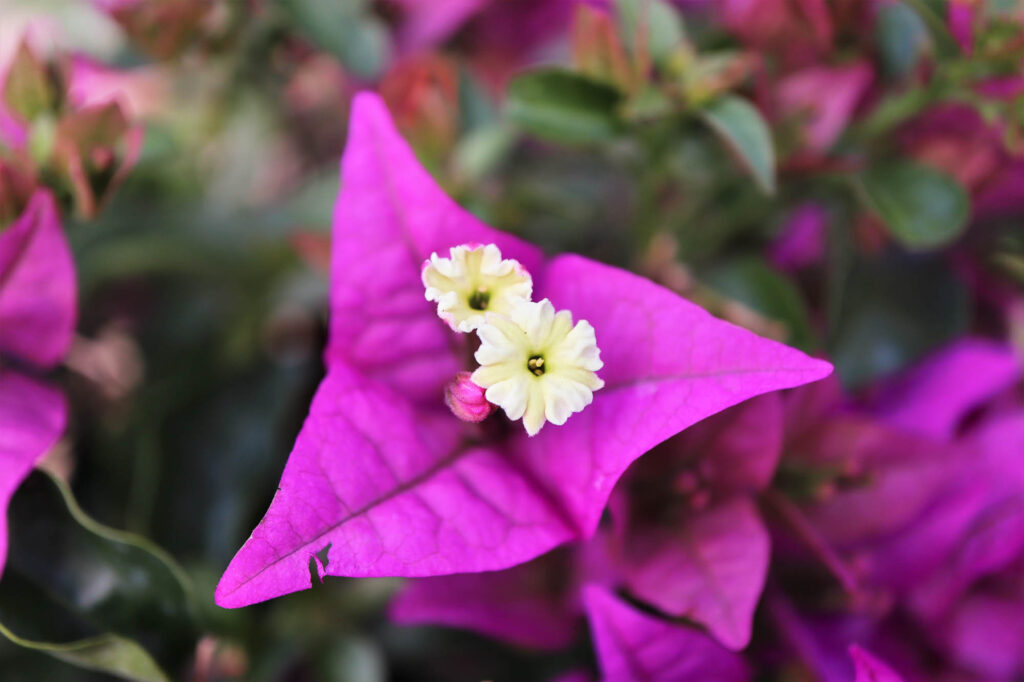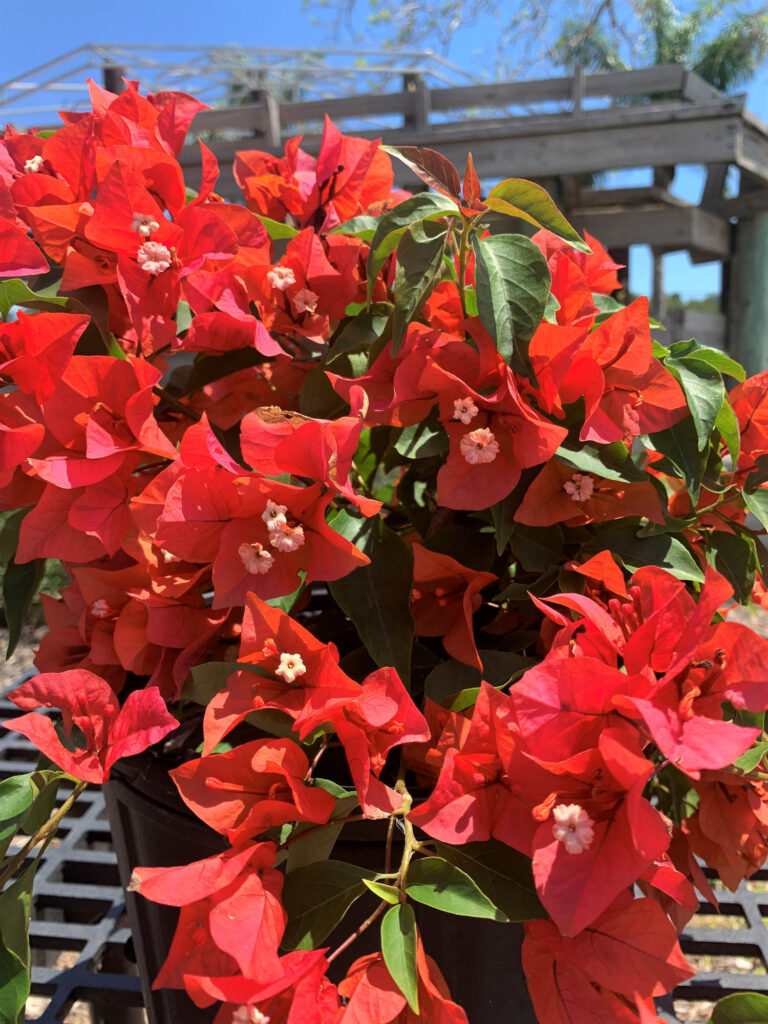by Amanda Rose Newton
Bougainvillea might not be the first plant on your mind this autumn season but maybe it should be.

Coming in shades of red, orange, and gold this stunning shrub might be the remedy for those missing Fall leaf color changes. Bougainvillea also comes in many variations, often donning the costume of a vine, braided tree, or a sprawling shrub, making it apt for Halloween.
While it is commonplace throughout Florida as well as the tropical climates of Africa, Asia, and Europe, its roots can be traced to South America.
Known and feared for its large thorns, the colorful bracts are really what grabs the attention of onlookers. The colorful “petals” of the bougainvillea are in reality bracts — special leaves that help keep a developing flower bud safe until it’s ready to bloom.

It does have flowers, but they might take a few glances to notice. The tiny white flowers usually sit amongst the clusters of bright heart-shaped bracts.
Planting Bougainvillea
The best attribute bougainvillea has going for it is its adaptability to just about any soil type. Best results are typically seen in areas where plants are situated in well-drained soil receiving sunlight at least 6 hours a day. Proper placement at ground level is also essential for success.
To borrow a horticulture phrase, bougainvillea dislikes having “wet feet” and is celebrated as a drought-tolerant plant.
Watering when you first plant them is essential to encourage healthy root growth and can be tapered back to an as-needed basis once the first 3 weeks of establishment pass.
If you (or someone you know) have trouble remembering to water, a xeriscape garden that features drought-tolerant species like bougainvillea can add significant color and texture not typically associated with the classic desert-like species that are common choices for this design.
Maintaining Your Bougainvillea
In order to get the flower power you desire, potassium will be needed in slightly higher amounts than might be typical for your other shrubs.
Consider fertilizing two times a year in March and October with a fertilizer specializing in blooming plants.
If you are trying to reduce your fertilization habit, amending your soil with quality compost or applying compost tea can help keep your plants blooming all season.
As hardy as bougainvillea’s exterior is, they are susceptible to a suite of pests. There is a bougainvillea caterpillar that received its nomenclature from favoring bougainvillea as a host plant.
An environmental concoction of Bt (Bacillius thurigenisis) will help reduce caterpillar woes. Of course, if you are a caterpillar lover like me, feel free to hand-pick them off or just leave them be. Your yard, your rules!
If your bougainvillea is not blooming as much as expected, it could be a myriad of issues. Sunlight is a huge determinant factor in bloom rate, so make sure you choose the right spot.

Too much nitrogen will encourage plant growth but not the flowering and fruiting aspect. For that to occur, you need potassium in the mix too. A well-amended soil should solve that problem with ease.
Brevard Friendly Bougainvillea’s
There are two main species of bougainvillea used in Brevard landscapes:
Bougainvillea spectabilis– the most frequently used and grows into a magnificent sprawling shrub or vine that can reach 20 feet in height. Comes in many colors including red, pink, orange, white, and purple.
Bougainvillea glabra– is in shrub form with smaller leaves than the spectabilis. The bracts come in lavender or purple. The max height for this one is 10 feet with a similar width.
For those without 10 feet to spare, there are two main dwarf species:
‘Helen Johnson’– This variation will top out at 3 feet tall and is about equal to that wide. New growth is copper and matures into a nice pink shade. This one can work potted on a balcony or patio or can be trained into a hedge or specimen tree.
‘Flame Dwarf Orange’ is another dwarf that gets roughly 5 feet in height. The bracts are a similar orange-pink and they can be grown in containers as well.
There are over 250 varieties of bougainvillea on the market today. This includes dwarf, the newer semi-dwarf, giant, and everything in between. There literally is a bougainvillea for everyone!
Think of bougainvilleas as your answer to missed autumn colors during your Florida Fall.


